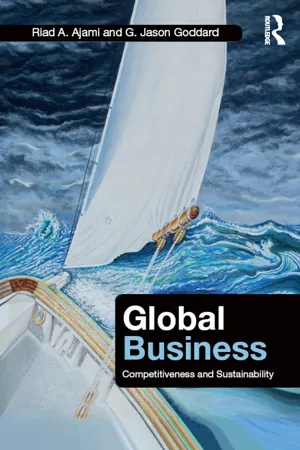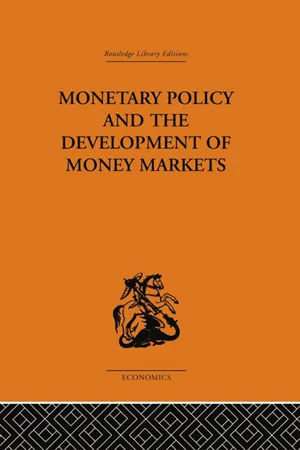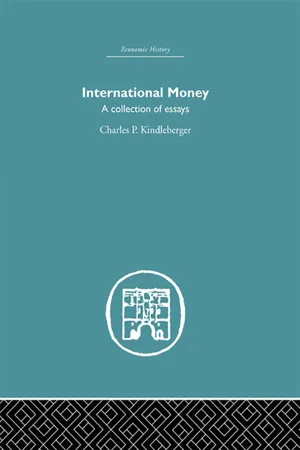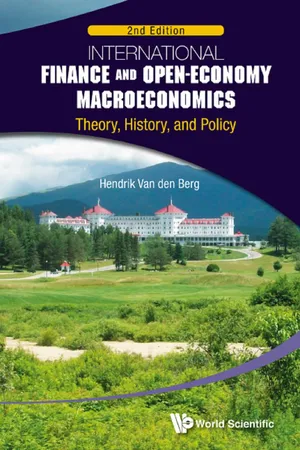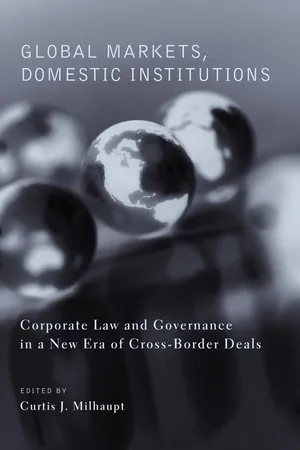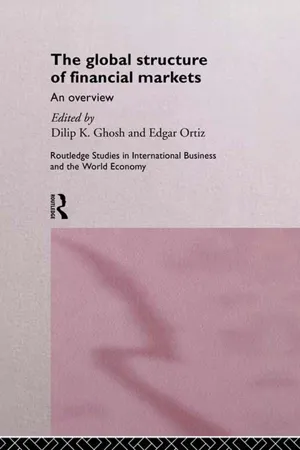Economics
International Capital Market
The International Capital Market refers to the global network of financial institutions, investors, and markets where companies and governments can raise funds from investors around the world. It provides a platform for the buying and selling of various financial instruments, such as stocks, bonds, and currencies, across international borders. This market plays a crucial role in facilitating global investment and capital flows.
Written by Perlego with AI-assistance
Related key terms
8 Key excerpts on "International Capital Market"
- eBook - ePub
Global Business
Competitiveness and Sustainability
- Riad A. Ajami, G. Jason Goddard(Authors)
- 2017(Publication Date)
- Routledge(Publisher)
International Capital Markets have become increasingly important as a source for financing the operations of MNCs, not only because of the decline in bank financing, but also largely because of several developments that have increased the competitiveness, size, and sophistication of the financial markets themselves. International Capital Markets or international financial markets are terms used to describe the three basic types of markets where MNCs can raise money: national financial markets, Eurocurrency markets, and national stock markets.It should be noted, however, that both national financial markets and national stock markets are international in the sense that, although they are located in a particular country and are subject to that country's laws and regulations, they are open to foreign borrowers and investors. The degree to which they are internationalized varies, of course, but in general the financial and equity markets of nearly all the industrialized countries are open to foreign borrowers.An essential difference between borrowing funds from a bank and raising funds from a financial market is that when a corporation borrows from a bank, the bank takes on the risk, and the depositors who place funds with the bank are not in any way responsible. Because the bank is taking the risk and going through the effort of pooling the funds of depositors, it receives certain remuneration, which can be quite high. On the other hand, borrowing in a financial market implies that a corporation is reaching the investing public directly, without using the intermediary services provided by the bank. The corporation has to make the necessary arrangements on its own to inform the investors that it is in the market to raise funds and to convince them of its credit-worthiness. Some banks, especially investment banks, do play a role in such transactions, but it is marginal in the sense that they provide only certain types of services, which are paid for by fees. Generally, therefore, corporations find it cheaper to raise funds through the International Capital Markets because they are able to save the intermediation costs involved in bank financing.Another important reason why MNCs would use this option is the sheer size of the resources that can be raised in these markets. There are limits on which banks can lend funds because they do not have such large resources at their disposal and are not willing to take excessive risks. - eBook - ePub
An Introduction to International Capital Markets
Products, Strategies, Participants
- Andrew M. Chisholm(Author)
- 2009(Publication Date)
- Wiley(Publisher)
1 Introduction: The Market Context1.1 CAPITAL AND THE CAPITAL MARKETS
Financial capital can be defined as accumulated wealth that is available to create further wealth. The capital markets are places where those who require additional funds seek out others who wish to invest their excess. They are also places where participants can manage and spread their risks. Originally, capital markets were physical spaces such as coffee houses and then purpose-built exchanges. In our day, capital markets participants may be located in different continents and conduct deals using advanced information technology.Who are the users of capital? In a broad sense we all are, at least part of the time. We borrow money to buy a house or a car so that we can live our lives, do our jobs, and make our own small contribution to the growing wealth of nations. We save to pay school and university tuition fees, investing in the ‘human capital’ that will sustain the economic health of the country. More narrowly, though, financial capital is used by corporations, governments, state and municipal authorities, and international agencies to make investments in productive resources. When a company builds a new factory it is engaged in capital expenditure - using funds provided by shareholders or lenders or set aside from past profits to purchase assets used to generate future revenues. Governments use tax revenues to invest in infrastructure projects such as roads. Agencies such as the World Bank inject funds into developing countries to create a basis for economic growth and future prosperity.Who are the suppliers of capital? Again, the answer is that we all are. Sometimes we do this directly by buying shares issued by corporations and debt securities issued by governments and their agencies. Sometimes we employ brokers to invest funds on our behalf. We deposit cash in bank accounts, invest in mutual funds, and set aside money in pension plans for our retirement. We pay taxes to the government and local authorities. We pay premiums to insurance companies who invest the proceeds against their future liabilities. Companies too become sources of capital when they reinvest their profits rather than paying cash dividends to shareholders. - eBook - ePub
Corporate Finance
Theory and Practice
- Pierre Vernimmen, Pascal Quiry, Yann Le Fur(Authors)
- 2022(Publication Date)
- Wiley(Publisher)
market-based economy, companies cover most of their financing needs by issuing financial securities (shares, bonds, commercial paper, etc.) directly to investors. A capital market economy is characterised by direct solicitation of investors' funds. Economic agents with surplus resources invest a large portion of their funds directly in the capital markets by buying companies' shares, bonds, commercial paper or other short-term negotiable debt. They do this either directly or through mutual funds. Intermediation gives way to the brokerage function, and the business model of financial institutions evolves towards the placement of companies' securities directly with investors.In this economic model, bank loans are extended primarily to households in the form of consumer credit, mortgage loans, etc., as well as to small enterprises that do not have access to the capital markets.The following graphs provide the best illustration of the rising importance of capital markets.…be it in terms of the number of listed companies…Note: Domestic companies only.Source: Data from World Federation of Exchanges, NYSE-Euronext, London Stock Exchange, Bourse de Casablanca, Bolsa Madrid, Beirut Stock Exchange, Borsa Italiana…or market capitalisationSource: Data from World Federation of Exchanges, NYSE-Euronext, Beirut Stock exchange, Borsa Italiana, London Stock ExchangeTransaction volumes are linked to the economic environment, even if the long-term trend shows a clear increase.Source: Data from World Federation of Exchanges, SIFMASection 15.2 PRIMARY, SECONDARY AND DERIVATIVE MARKETS
1/ FROM THE PRIMARY MARKET TO THE SECONDARY MARKET
The new issues market (i.e. creation of securities) is called the primary market. Subsequent transactions involving these securities take place on the secondary market. Both markets, like any market, are defined by two basic elements: the product (the security) and the price (its value).Thus, shares issued or created when a company is founded can later be floated on a stock exchange, just as long-term bonds may be used by speculators for short-term strategies. The life of a financial security is intimately connected with the fact that it can be bought or sold at any moment. - J.S.G. Wilson(Author)
- 2013(Publication Date)
- Routledge(Publisher)
At the short end of the capital market, the development of the Euro-dollar market (and similar markets in other international currencies) has already indicated both the potentialities and the probable effects. There can be little doubt that the rate and volume of capital flows between nations have increased and that a greater international consistency in short-and medium-term interest rates has emerged in consequence. If interest rates in one country get out of line with those in other countries (after allowing for the premium or discount on forward cover) operators in Euro-dollars will be induced to switch funds into the market with the relatively high rate. Such switches could complicate matters for the monetary authorities in the countries concerned (e.g. an easing of credit with lower domestic rates of interest could lead to a net outflow of funds), though interest rate differentials (adjusted for the cost of forward cover) are unlikely to exert their full effects because of a variety of artificial barriers (e.g. inter-bank agreements covering minimum rates on loans; an understanding that loans in foreign currency should be made to the foreign sector only; or the reimposition of capital control regulations). In any event, the further development of markets of this type can only affect indirectly the markets for long-term capital.The two things that an International Capital Market must ensure are (1) that capital can be made available in appropriately large amounts (the amount that can be raised in most national capital markets by any one issue is distinctly limited)—the ready availability of capital is in fact a more important consideration for most large borrowers than the actual costs of issue, though quite apparently the latter must be competitive; and (2) that there will always be a ready market should the investor wish to dispose of his securities—this postulates a degree of breadth and activity such as is only found today in New York and (possibly) London.Making capital available (or eliciting savings) and ensuring marketability are but part of the same process. Under both heads, much can be achieved by improving the institutional mechanism. Basically what must be sought are the most efficient means of protecting the interests of investors, while providing borrowers with the volume of funds required and at reasonable rates. The more efficient the market the better will both sets of interests be served.- eBook - ePub
International Money
A Collection of Essays
- Charles P. Kindlerberger(Author)
- 2013(Publication Date)
- Routledge(Publisher)
On occasion, issues will be debated which are more hypothetical than real – such as the need to cope with a prospective shortage of international liquidity discussed by economists now since the mid-1950s. At other times sharp changes will occur in economic institutions virtually unnoticed. The contention of this chapter is that the world has moved toward a world capital market since the restoration of convertibility in 1958, and away from it since the Interest Equalization Tax (IET) of 1963 and the Kuponsteuer of 1964, without adequate discussion of the larger issues whether an International Capital Market fulfills an important function in the international economic system, or whether it causes more and more severe problems than it solves. Opinions are offered on one or the other side of these issues, from time to time, but often incidentally to the treatment of rather different questions, and ex cathedra without full discussion. Thus the report of Working Party no. 3 of the Organization for Economic Co-operation and Development (OECD) of August 1966 on ‘Balance-of-Payments Adjustment’ makes passing reference to the usefulness of an International Capital Market, but suggests that if balance-of-payments disequilibrium is caused by ‘excessive’ capital movements, it should be treated by restrictions on capital flows - eBook - ePub
International Finance and Open-Economy Macroeconomics
Theory, History, and Policy
- Hendrik Van den Berg(Author)
- 2016(Publication Date)
- WSPC(Publisher)
In most developed countries, and in an increasing number of developing economies, we see an increasing variety of financial markets and intermediaries functioning simultaneously. The complexity of financial intermediation, especially the problems of moral hazard, adverse selection, asymmetric information, fraud, and contract enforcement, explains this variety. For example, relatively inexpensive financial markets such as bond and stock markets can exchange the stocks and bonds of well-known corporations whose value can be easily judged by most savers. But, small unknown firms rely more on banks, which have traditionally been set up to devote resources to investigating and monitoring small business firms and their projects. Financial intermediaries such as banks, pension funds, mutual funds, and insurance companies are good at pooling risk, something that individual savers cannot easily do by themselves. Thus, stock and bond markets will normally coexist with banks, pension funds, and insurance companies in what we broadly term the financial sector of the economy. The more developed the financial sector, the greater the variety of financial markets and intermediaries.The development of stock and bond markets in many countries has enabled the growth of what we call international portfolio investment, the cross-border trade in assets like stocks and bonds by savers seeking to diversify and reduce the overall risk of their wealth. In this section, we briefly examine portfolio investment in the international economy.17.5.1 Defining portfolio investment
Portfolio investment - eBook - ePub
Global Markets, Domestic Institutions
Corporate Law and Governance in a New Era of Cross-Border Deals
- Curtis Milhaupt(Author)
- 2003(Publication Date)
- Columbia University Press(Publisher)
Part III Globalization and the Capital MarketsPassage contains an image
13 The Impact of Cross-Listings and Stock Market Competition on International Corporate Governance John C. Coffee, Jr.Today, there are an estimated 150 securities exchanges trading stocks around the world (see Vision Test 2001). Soon, this number is likely to shrink radically. Indeed, this was the U.S. experience at the beginning of the twentieth century when over 100 securities exchanges in the United States operated, until they were compelled to consolidate or simply shut down, as improved communications and transportation systems lowered the informational cost barriers that had sustained them. Today, the two great forces reshaping the contemporary world—globalization and technology—appear to be forcing a similar consolidation. Because globalization has lowered the barriers to cross-border capital flows, including in particular traditional restrictions on foreign investments in domestic stocks, and because technology has made instantaneous information flows feasible, securities markets can now compete on a global basis that never previously was possible. As a result, issuers, particularly those in emerging economies, have a choice of markets on which to list their securities and raise equity capital.Predictably, once this competition begins, a natural consequence will be a wave of mergers, consolidations, and related alliances among securities markets. But where does this process end? Many who have studied this new competition have assumed that the winners (or at least the survivors) in this consolidation process will be those who can offer the greatest liquidity, or the lowest trading costs, or the most advanced technology. Some believe that this competition will inherently result in a “winner-takes-all” contest that will leave only a few large pools of liquidity in major international financial centers (see DiNoia 2001). The premise here is that “liquidity attracts liquidity” (ibid.: 55), and thus larger markets should drain order flow and liquidity from smaller markets, ultimately leaving them hollowed-out shells. - eBook - ePub
- Dilip K. Ghosh, Dilip K Ghosh*Cnp*, Edgar Ortiz(Authors)
- 2005(Publication Date)
- Routledge(Publisher)
Part I
GLOBAL CAPITAL MARKETS
Passage contains an image
2
GLOBALIZATION OF BUSINESS AND FINANCE AND EMERGING CAPITAL MARKETS
Edgar Ortiz*INTRODUCTION
Growth in trade and investments, important changes in production and technology, meaningful innovations in telecommunications and computer applications, and a generalized trend towards liberalization and deregulation of domestic and international markets have led during the last two decades to a closer and deeper interaction among international markets, e.g. economic and financial globalization. As a result the structure of financial markets has changed significantly and new international business opportunities, operations, networks and challenges have appeared. Correctly, changes at the end of the twentieth century have been identified as an early stage of another “great leap forward.” (Tung and Miller, 1990). Financial systems from both developed and developing countries have been subject to change. However, transformations in the developing countries have been deeper because most of them were characterized by some form of “financial repression” and protectionism. Hence, those changes could be characterized as a systemic transition from highly state-intervened to market-oriented and open economies. In addition, financial transformation in the developing countries could be identified as a strategy followed to promote favorable links with international financial markets, and as a transition to higher stages of economic development. Finally, in some cases, this situation could be also identified as an about face from state-led socialism into capitalism. The domestic and international factors that impact the nature of these promising transitions need to be further analyzed.A key component of recent changes in the financial sector from the developing countries has been the impressive growth and internationalization of their capital markets. These markets have acquired great importance for the mobilization of international resources to support the continuing and expanding needs of those countries to finance their economic activity. However, this role cannot be successful unless some local inefficiencies that reinforce each other are eliminated. High returns and a favorable prospective, involving migrations to competing markets, have fueled a great deal of interest in investing in and studying the characteristics of the most successful “emerging capital markets.” Nevertheless, the literature has neglected to examine the relationship and implications that inefficiencies derived from traditional patterns of corporate governance, asymmetrical information and weak links of foreign capital flows with the real sectors of the economy can have on the integration of those markets with the world economy. Possible instabilities due to the integration of the local markets with regional and global markets need to be assessed, too.
Index pages curate the most relevant extracts from our library of academic textbooks. They’ve been created using an in-house natural language model (NLM), each adding context and meaning to key research topics.
